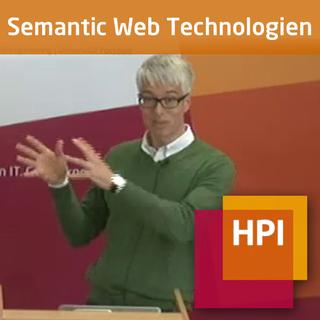
Das Web ist heute schon längst zum festen Bestandteil unseres täglichen Lebens geworden. Doch was haben wir außer einer gigantischen und unsortierten Flut von Informationen gewonnen? Wir alle kennen das Problem: Suchen wir nach einer bestimmten Information, werden wir von einer Lawine unnötiger und nicht relevanter Information erschlagen und das Herauspicken der wirklich wichtigen Details gestaltet sich als langwieriger und aufwändiger Prozess.
Semantic Web Technologien bieten mit Hilfe formaler interoperabler Metadatenstandards einen möglichen Ausweg aus diesem Dilemma. Grundgedanke dabei ist es, die Bedeutung der Web-Inhalte mit Hilfe geeigneter Wissensrepräsentationstechniken zu formalisieren und zu annotieren. Dadurch wird deren Semantik nicht nur maschinenlesbar, sondern maschinenverstehbar. Neue Fakten können aus vorhandenen Informationen gewonnen werden und automatisch von einer Vielzahl neuer Anwendungen automatisch kombiniert und genutzt werden.
| Introduction | 01:23:58 | |
|---|---|---|
| Introduction | 00:18:26 | |
| From Internet to Web 2.0 | 00:15:57 | |
| Quo Vadis WWW? | 00:23:19 | |
| Semantic Web | 00:16:20 | |
| Applications | 00:09:56 |
| Resource Description Framework | 01:27:23 | |
|---|---|---|
| RDF und RDFa | 00:11:58 | |
| Vokabular | 00:22:56 | |
| Semantik im WWW | 00:12:42 | |
| Zusätzliche Funktionalität | 00:26:13 | |
| RDF und html 5 | 00:13:34 |
| Query Language SPARQL | 01:31:04 | |
|---|---|---|
| SPARQL | 00:10:14 | |
| SPARQL 1.0 | 00:18:12 | |
| SPARQL Query Format | 00:20:33 | |
| SPARQL Result Format | 00:11:14 | |
| SPARQL 1.1 | 00:12:52 | |
| Property Parts | 00:17:59 |
| Knowledge Representation and Logics | 01:30:19 | |
|---|---|---|
| Ontologies | 00:20:23 | |
| Ontology in Classical Greek Philosophy | 00:20:01 | |
| Ontologies in Late Antiquity and Early Middle Ages | 00:19:44 | |
| How should we represent Ontologies? | 00:20:35 | |
| Ontology Types | 00:09:36 |
| Popositional Logic and First Order Logic | 01:33:09 | |
|---|---|---|
| Foundations of Logic | 00:16:11 | |
| Variants of Semantics | 00:23:41 | |
| PL - Model-theoretic Semantics | 00:16:53 | |
| Canonical Form | 00:16:38 | |
| Resolution | 00:19:46 |
| Description Logics | 01:36:42 | |
|---|---|---|
| Motivation | 00:12:55 | |
| Description Logics Overview | 00:17:11 | |
| ALC - Syntax and Semantic | 00:18:21 | |
| Inference and Reasoning | 00:18:35 | |
| Tableaux Algorithm | 00:14:03 | |
| Tableaux Algorithm Extensions for FOL | 00:15:37 |
| RDF(S) | 01:23:52 | |
|---|---|---|
| Why do we need semantics for RDF(S) | 00:11:23 | |
| Model-theoretic semantics | 00:10:31 | |
| Simple Interpretation | 00:17:24 | |
| RDF Interpretation | 00:06:23 | |
| RDFS Interpretation | 00:11:22 | |
| RDF(S) RDF(S) Entailment | 00:18:36 | |
| Completeness of the Deduction Calculus | 00:07:43 |
| OWL and OWL Semantics | 01:20:00 | |
|---|---|---|
| OWL 1 - Overview | 00:14:57 | |
| OWL 1 - Syntax Variants | 00:34:39 | |
| Properties | 00:09:58 | |
| Tools | 01:20:00 |
| OWL 2 | 01:28:00 | |
|---|---|---|
| Development of OWL2 | 00:11:45 | |
| From SHOIN(D) to SHROIK(D) | 00:13:26 | |
| General Property Inclusion | 00:23:27 | |
| OWL2 Syntax | 00:17:00 | |
| Complexity and other Properties | 00:08:23 | |
| OWL2 Profiles | 00:13:59 |
| Rules & the Semantic Web | 01:25:40 | |
|---|---|---|
| OWL2 Web Ontology Language | 00:05:36 | |
| Can we do SPARQL with OWL? | 00:15:12 | |
| Rules from a Semantic Web Perspective | 00:18:20 | |
| Rules for OWL and SWRL | 00:09:36 | |
| Rules expressible in OWL | 00:25:08 | |
| Exchanging Rules with RIF | 00:11:48 |
| Ontological Engineering | 01:25:06 | |
|---|---|---|
| In General | 00:23:38 | |
| Method of Ushold and King | 00:13:50 | |
| Ontology 101 | 00:10:23 | |
| Unified Process for Ontology | 00:10:10 | |
| Ontology Design Patterns | 00:07:20 | |
| Ontology Learning | 00:09:51 | |
| Ontology Mapping | 00:09:54 |
| Linked Data Engineering & Semantic Search | 01:27:18 | |
|---|---|---|
| How to get Data from the Web | 00:06:38 | |
| Linked Data Principles | 00:18:24 | |
| Creative Common CC-BY | 00:11:56 | |
| Information Retrieval | 00:06:43 | |
| Search Engines in the Web | 00:23:08 | |
| How to use semantic data in Retrieval | 00:20:29 |